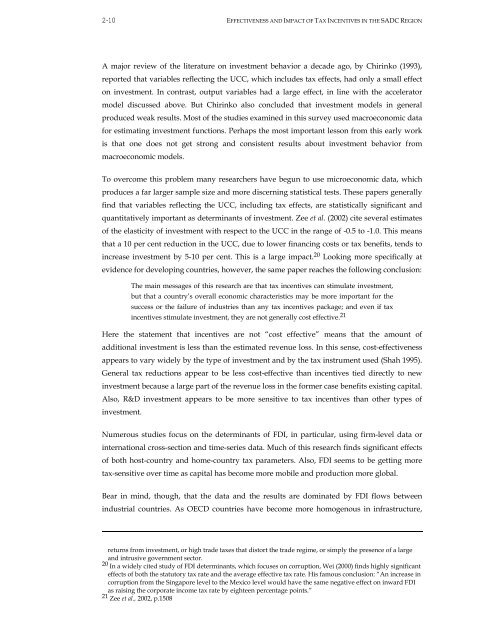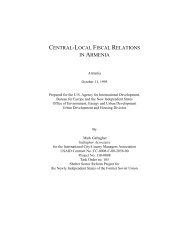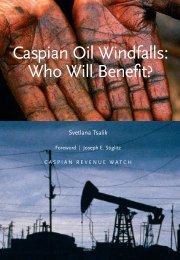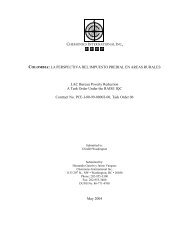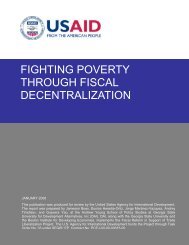Effectiveness and Economic Impact of Tax Incentives in the SADC ...
Effectiveness and Economic Impact of Tax Incentives in the SADC ...
Effectiveness and Economic Impact of Tax Incentives in the SADC ...
You also want an ePaper? Increase the reach of your titles
YUMPU automatically turns print PDFs into web optimized ePapers that Google loves.
2-10 EFFECTIVENESS AND IMPACT OF TAX INCENTIVES IN THE <strong>SADC</strong> REGION<br />
A major review <strong>of</strong> <strong>the</strong> literature on <strong>in</strong>vestment behavior a decade ago, by Chir<strong>in</strong>ko (1993),<br />
reported that variables reflect<strong>in</strong>g <strong>the</strong> UCC, which <strong>in</strong>cludes tax effects, had only a small effect<br />
on <strong>in</strong>vestment. In contrast, output variables had a large effect, <strong>in</strong> l<strong>in</strong>e with <strong>the</strong> accelerator<br />
model discussed above. But Chir<strong>in</strong>ko also concluded that <strong>in</strong>vestment models <strong>in</strong> general<br />
produced weak results. Most <strong>of</strong> <strong>the</strong> studies exam<strong>in</strong>ed <strong>in</strong> this survey used macroeconomic data<br />
for estimat<strong>in</strong>g <strong>in</strong>vestment functions. Perhaps <strong>the</strong> most important lesson from this early work<br />
is that one does not get strong <strong>and</strong> consistent results about <strong>in</strong>vestment behavior from<br />
macroeconomic models.<br />
To overcome this problem many researchers have begun to use microeconomic data, which<br />
produces a far larger sample size <strong>and</strong> more discern<strong>in</strong>g statistical tests. These papers generally<br />
f<strong>in</strong>d that variables reflect<strong>in</strong>g <strong>the</strong> UCC, <strong>in</strong>clud<strong>in</strong>g tax effects, are statistically significant <strong>and</strong><br />
quantitatively important as determ<strong>in</strong>ants <strong>of</strong> <strong>in</strong>vestment. Zee et al. (2002) cite several estimates<br />
<strong>of</strong> <strong>the</strong> elasticity <strong>of</strong> <strong>in</strong>vestment with respect to <strong>the</strong> UCC <strong>in</strong> <strong>the</strong> range <strong>of</strong> -0.5 to -1.0. This means<br />
that a 10 per cent reduction <strong>in</strong> <strong>the</strong> UCC, due to lower f<strong>in</strong>anc<strong>in</strong>g costs or tax benefits, tends to<br />
<strong>in</strong>crease <strong>in</strong>vestment by 5-10 per cent. This is a large impact. 20 Look<strong>in</strong>g more specifically at<br />
evidence for develop<strong>in</strong>g countries, however, <strong>the</strong> same paper reaches <strong>the</strong> follow<strong>in</strong>g conclusion:<br />
The ma<strong>in</strong> messages <strong>of</strong> this research are that tax <strong>in</strong>centives can stimulate <strong>in</strong>vestment,<br />
but that a country’s overall economic characteristics may be more important for <strong>the</strong><br />
success or <strong>the</strong> failure <strong>of</strong> <strong>in</strong>dustries than any tax <strong>in</strong>centives package; <strong>and</strong> even if tax<br />
<strong>in</strong>centives stimulate <strong>in</strong>vestment, <strong>the</strong>y are not generally cost effective. 21<br />
Here <strong>the</strong> statement that <strong>in</strong>centives are not “cost effective” means that <strong>the</strong> amount <strong>of</strong><br />
additional <strong>in</strong>vestment is less than <strong>the</strong> estimated revenue loss. In this sense, cost-effectiveness<br />
appears to vary widely by <strong>the</strong> type <strong>of</strong> <strong>in</strong>vestment <strong>and</strong> by <strong>the</strong> tax <strong>in</strong>strument used (Shah 1995).<br />
General tax reductions appear to be less cost-effective than <strong>in</strong>centives tied directly to new<br />
<strong>in</strong>vestment because a large part <strong>of</strong> <strong>the</strong> revenue loss <strong>in</strong> <strong>the</strong> former case benefits exist<strong>in</strong>g capital.<br />
Also, R&D <strong>in</strong>vestment appears to be more sensitive to tax <strong>in</strong>centives than o<strong>the</strong>r types <strong>of</strong><br />
<strong>in</strong>vestment.<br />
Numerous studies focus on <strong>the</strong> determ<strong>in</strong>ants <strong>of</strong> FDI, <strong>in</strong> particular, us<strong>in</strong>g firm-level data or<br />
<strong>in</strong>ternational cross-section <strong>and</strong> time-series data. Much <strong>of</strong> this research f<strong>in</strong>ds significant effects<br />
<strong>of</strong> both host-country <strong>and</strong> home-country tax parameters. Also, FDI seems to be gett<strong>in</strong>g more<br />
tax-sensitive over time as capital has become more mobile <strong>and</strong> production more global.<br />
Bear <strong>in</strong> m<strong>in</strong>d, though, that <strong>the</strong> data <strong>and</strong> <strong>the</strong> results are dom<strong>in</strong>ated by FDI flows between<br />
<strong>in</strong>dustrial countries. As OECD countries have become more homogenous <strong>in</strong> <strong>in</strong>frastructure,<br />
returns from <strong>in</strong>vestment, or high trade taxes that distort <strong>the</strong> trade regime, or simply <strong>the</strong> presence <strong>of</strong> a large<br />
<strong>and</strong> <strong>in</strong>trusive government sector.<br />
20 In a widely cited study <strong>of</strong> FDI determ<strong>in</strong>ants, which focuses on corruption, Wei (2000) f<strong>in</strong>ds highly significant<br />
effects <strong>of</strong> both <strong>the</strong> statutory tax rate <strong>and</strong> <strong>the</strong> average effective tax rate. His famous conclusion: “An <strong>in</strong>crease <strong>in</strong><br />
corruption from <strong>the</strong> S<strong>in</strong>gapore level to <strong>the</strong> Mexico level would have <strong>the</strong> same negative effect on <strong>in</strong>ward FDI<br />
as rais<strong>in</strong>g <strong>the</strong> corporate <strong>in</strong>come tax rate by eighteen percentage po<strong>in</strong>ts.”<br />
21 Zee et al., 2002, p.1508


